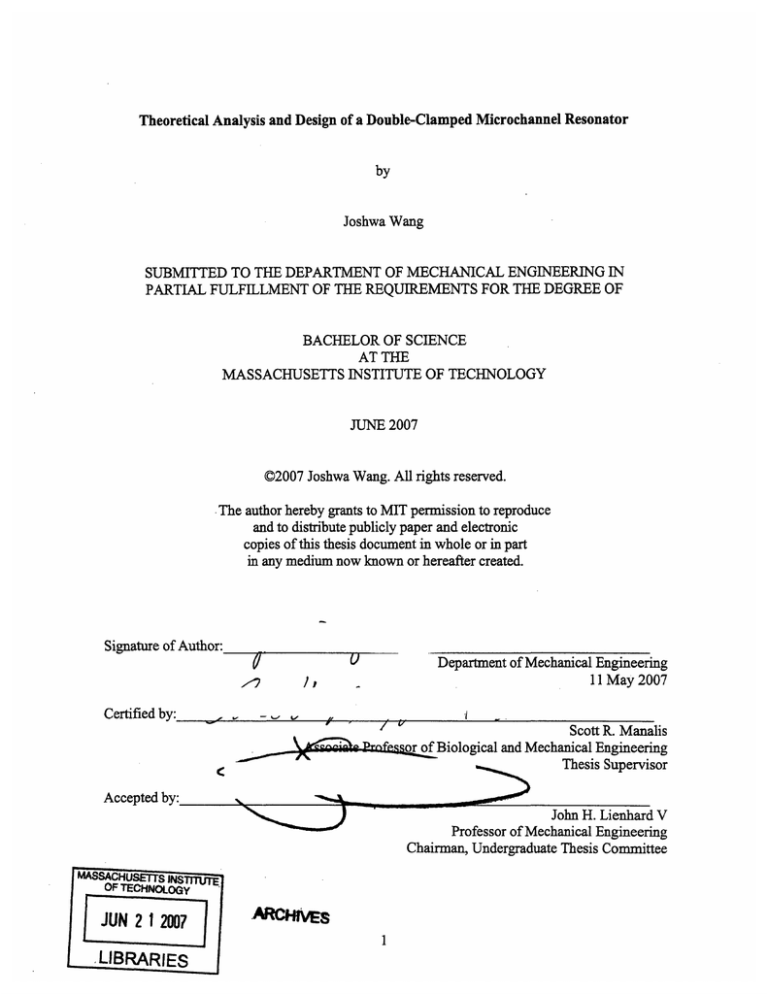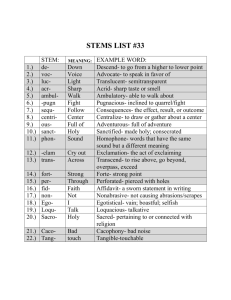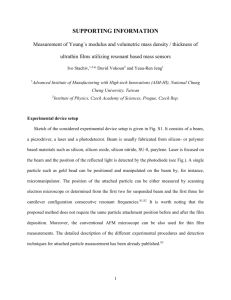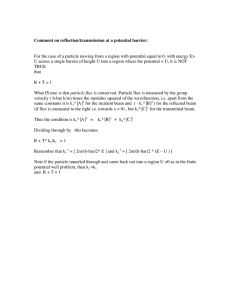
Theoretical Analysis and Design of a Double-Clamped Microchannel Resonator
by
Joshwa Wang
SUBMITTED TO THE DEPARTMENT OF MECHANICAL ENGINEERING IN
PARTIAL FULFILLMENT OF THE REQUIREMENTS FOR THE DEGREE OF
BACHELOR OF SCIENCE
AT THE
MASSACHUSETTS INSTITUTE OF TECHNOLOGY
JUNE 2007
©2007 Joshwa Wang. All rights reserved.
The author hereby grants to MIT permission to reproduce
and to distribute publicly paper and electronic
copies of this thesis document in whole or in part
in any medium now known or hereafter created.
Signature of Author:
Department of Mechanical Engineering
11 May 2007
,/
Certified by:
S/
P
V,
Scott R. Manalis
.orqof Biological and Mechanical Engineering
..
Thesis Supervisor
Accepted by:
John H. Lienhard V
Professor of Mechanical Engineering
Chairman, Undergraduate Thesis Committee
MASSACHUSETTS INSTJTLRJE
OF TECHNOLOGy
JUN 2 12007
,LIBRARIES
ARCHIVES
Theoretical Analysis and Design of a Double-Clamped Microchannel Resonator
by
Joshwa Wang
Submitted to the Department of Mechanical Engineering
on May 11, 2007, in Partial Fulfillment of the
requirements for the Degree of Bachelor of Science in
Mechanical Engineering.
ABSTRACT
The Suspended Microchannel Resonator (SMR) that is currently being used by the Nanoscale
Sensing Group is the inspiration for this thesis. This work examines Master's degree candidate
Sungmin Son's theoretical analysis of a cantilevered microchannel beam that is fixed at both
ends. The current design used in lab is a traditional cantilevered beam and has been successful in
producing results in the detection of biological molecules. This new design is an experiment on
whether adequate mass sensitivity, readability, and reliable range can be reproduced using a
different type of boundary condition and alternate geometry. My thesis will analyze Son's work
to determine what types of mass sensitivity, readability, and reliable range can be achieved by
altering the microchannel geometry.
Thesis Supervisor: Scott R. Manalis
Title: Associate Professor of Biological and Mechanical Engineering
Table of Contents
1. Introduction...............................................................................................4
1.1 Purpose............................................................................................. 4
1.2 Project O verview ..................................................................................... 4
1.3 Organization...........................................................................................4
1.4 Acknowledgements...................................................................................5
2. Project Background.............................................................................
... 5
2.1 Quartz-Crystal Microbalance........................................................................5
2.2 Surface Plasmon Resonance........................................................................5
2.3 Suspended Microchannel Resonator................................................................5
3. Double-Clamped Microchannel Resonator.........................................................6
3.1 Theoretical Analysis.................................................................................6
3.1.1 Equation of Motion.................................................................................6
3.1.2 Boundary Conditions...............................................................................7
3.1.3 Solution for Resonant Frequency of Overpass.................................................7
3.2 Mass Sensitivity.......................................................................................9
3.3 R eadability.............................................................................................9
3.4 R eliable R ange.......................................................................................10
4. Alternate Designs.......................................................................................13
5. Results....................................................................................................14
5.1 Mass Sensitivity Analysis..........................................................................14
5.2 Readability...........................................................................................14
5.3 Reliable R ange.......................................................................................16
6. Design Issues.............................................................................................18
6.1 Fatigue Failure.......................................................................................18
6.2 Particle Deviation....................................................................................19
7. Conclusions..............................................................................................20
1.
Introduction
Currently in the field of biomedical devices there is a need for real-time, high throughput
detection of molecular interactions. The Nanoscale Sensing Group has utilized a device known
as the Suspended Microchannel Resonator (SMR) designed by Thomas Burg of the group to
detect interactions such as binding between avidin and biotinylated serum albumin. The SMR
relies on detecting shifts in resonant frequency of the cantilevered, suspended microfluidic
channel as biological molecules accumulate within the channel. Sungmin Son of the Nanoscale
Sensing Group has analyzed the feasibility as well as the unique characteristics that can observed
by using a microfluidic channel that is anchored from both ends as opposed to being
cantilevered. By varying the geometry of the microfluidic or "overpass" channel, the mass
sensitivity, readability, and reliable range may be manipulated to produce results that are
adequate for use in experiments.
1.1
Purpose
We would like to analyze the feasibility of using alternate geometries and boundary conditions
for a double-clamped overpass channel. From these analyses we should gain a greater
understanding of whether this is possible while still maintaining adequate mass sensitivity,
readability, and reliable range for the detection of biological molecules and their interactions.
1.2
Project Overview
This project stemmed from the device that is currently being used by the Nanoscale Sensing
Group here at MIT. They currently use a cantilevered microfluidic channel more commonly
known as the Suspended Microchannel Resonator (SMR). Using this device one can measure the
mass of biological molecules by monitoring the change in resonant frequency of the beam as a
particle is passed within it. Sungmin Son of the group began experimenting with the idea of
implementing a double-clamped beam and altering the geometry to observe what the feasibility
was of exploring other geometries.
1.3
Organization
This report will give an overview and analysis of the design of a double-clamped microchannel
resonator. Section 2 will provide background information and the current methods being
employed in biological detection. Section 3 will give a theoretical analysis for the doubleclamped microchannel resonator that Son worked on. Section 4 covers alternate designs for a
double-clamped overpass channel and a comparison of their attributes. Section 5 will cover the
results from Matlab and Ansys analysis of the double-clamped channel and the alternate designs.
Section 6 considers design issues that are important in the design of the double-clamped
microresonator. Finally section 7 will conclude this thesis and offer suggestions for future
research.
1.4
Acknowledgements
I would like to thank Professor Scott Manalis and everyone at the Nanoscale Sensing Group at
MIT. It was a good experience getting to know everyone in the lab and learning from their
experience. In particular I would like to extend my deepest gratitude to Sungmin Son who began
to explore the idea behind my thesis. Without all these individuals this thesis would never have
come to fruition.
2.
Project Background
The desire to understand and detect biological molecules with high accuracy and highthroughput has led to the advent of various devices used to aid researchers. Each device has
advantages and disadvantages depending on the matter being detected and how much resolution,
accuracy, and precision are needed in the measurements. These devices fall into a broad category
known as biosensors. Generally, the sensor is attached to a processing unit which converts a
response (the binding of biological molecules or the presence of a cell) into a change in electrical
or optical signal. This output provides useful information that may be analyzed. The SMR falls
into a specific class known as label-free biosensors. That is, the sample molecules do not require
preparation or fluorescent labeling which can interfere with the biological interactions that one
may wish to study. Currently, prominent label-free biosensing techniques are the quartz-crystal
microbalance (QCM) and surface plasmon resonance (SPR).
2.1
Quartz Crystal Microbalance
The QCM utilizes and piezoelectric quartz crystal which changes in resonant frequency when
disturbed by an external mass upon its surface. By determining the change in resonant frequency
of the quartz crystal, one may calculate the mass of the particle on the surface or determine the
thickness of a film deposited upon it. Although this method provides mass resolution in the
nanogram range, it requires a large sample volume (10-1000 pL) and is less sensitive than
fluorescence screening.
2.2
Surface Plasmon Resnonance
SPR is another type of label-free detector that uses optical detection techniques. This method
may be used to characterize the interactions of various biopolymers, including protein-ligand,
protein-protein, protein-DNA, and protein-membrane binding. Specifically, SPR can also be
used to quantify the equilibrium constants and kinetic constants. The major drawbacks on using
SPR are the large and expensive instrumentation as well as the large sample volumes (greater
than 100 gL) needed.
2.3
Suspended Microchannel Resonator
The device currently used by the Nanoscale Sensing Group counters many of the downsides
found in its label-free counterparts. Rather than requiring large sample volumes like QCM or
SPR, the SMR can work even with only picoliter sample volumes. Detection with the SMR
requires determining the shift in resonant frequency of a suspended microfluidic channel as
molecules gather along the inner wall. The SMR is actuated using electrostatic force and can be
interfaced directly with conventional microfluidic systems.
3.
The Double Clamped Microchannel Resonator
For the theoretical design of the double-clamped microchannel resonator, there are three matters
of concern. First, the device must have at least a mass resolution of 10- 17 g/jtm 2 (the current mass
resolution of the SMR). Second, the amplitude of oscillation for the microchannel must be large
enough to be detected using the optical setup used for the SMR. Finally, the reliable range must
be long enough so that an adequate measurement may be made as a biopolymer travels along the
length of the microfluidic channel.
To this end, Sungmin Son has explored the possibility and has conducted a theoretical analysis of
the feasibility of such an idea. To conclude, he has considered some other issues that would need
to be taken into account for the double-clamed microchannel resonator to come to fruition. The
issues being fatigue failure (how many oscillation the microchannel may sustain) and particle
deviation which may cause variance in output frequency due to the position of the particle along
the lateral width of the beam.
3.1
Theoretical Analysis
As mentioned previously the primary objectives are to achieve high mass sensitivity, large
oscillation amplitude, and long reliable range. To proceed with the analysis it is helpful to
understand some assumptions that are made at the beginning. First, gravitational effects are
ignorable as mentioned in the MEMS source book. Second, pressure effect within the
microfluidic channels is negligible as discussed in Thomas Burg's doctoral thesis. Finally, axial
force as the microchannel is oscillating is negligible. This was verified analytically using Ansys
FEA software package.
3.1.1 Equation of Motion
The following figure shows a basic drawing of the double-clamped beam oscillating in its first
mode shape.
fosin(cot)
.. - - "" ""Ymax
. . .
Figure 1. This figure shows the maximum oscillation of the double clamped beam in its
first mode shape and the sinusoidal electrostatic force imparted onto the beam.
In the figurefo is the electrostatic force applied to the double-cantilevered beam and Ymax is the
maximum displacement at the center of the beam.
Generally the equation of motion for a beam with respect to distance from the origin and time is
(1)
f
82y
(x,t) = pA a 2
at
+ EI
4y
Y
ax 4
at
where p is the density, A is the cross-sectional, E is the Young's Modulus, I is the area moment
of inertia of the beam. The damping constant is c.
3.1.2 Boundary Conditions
The double-clamped beam has the following boundary conditions
(2)
y(x,t) x 0 = 0
(3)
ay(x, t) -=0
ax =0
(4)
y(x,t)
x=L
-
ay(x,t)
(5)
ax
=0
x=L
Equations 2 and 4 describe the fixed nature of the two ends of the beam while equations 3 and 5
indicate that the velocity at the ends of the beams will remain at zero for all time. These
boundary conditions are necessary for solving the equation of motion for the beam.
3.1.3 Solution for Resonant Frequency of Overpass
To solve for the resonant frequency in the first mode shape of the double-clamped beam
separation of variables must be used. To solve equation 1 use the following general equation
(6)
y(x,t) = a(x)e"
Substituting equation 6 back into equation 1 the following equation is derived
(7)
2
pAco2a+
EI
d4
4
c+
ca
=0
dx
where w is the frequency of oscillation. Separation of variables requires that
(8)
d a =Aa
4
dx
and solving equation 7 for Xgives
Aco2 + cco
El
From the boundary conditions of the overpass at either fixed end
24
(9)
a(x = 0,L)
(10)
= da = 0
dx
where L is the length of the double-clamped microchannel. The general equation for a vibrating
system
(11)
a (x) = cl (-0.9825 sin 2x + cos ix + 0.9825 sinh 2x - cosh 2x)
along with the boundary conditions given in equation 10 yields a constant
(12)
(AL) =4.73
for the first mode shape of vibration.
Using the quadratic method to solve equation 9, the frequency of the overpass channel is derived
(13)
mo = -(13)c c2 -4EIpAV4
2pA
To determine the resonant frequency of the beam, the imaginary portion of the quadratic solution
in equation 13 is used
(14)
4EIpA2 4 -
= S2
2
pA
pA
For purposes of this theoretical analysis the damping coefficient is considered sufficiently low
such that c is approximately zero. Therefore
(15)
COr = Ct2r
Where 4=3.33X10 -5 when the quality factor is Q= 15,000. This value for the quality factor comes
from Thomas Burg's thesis and is a benchmark value used for the suspended microchannel
resonator in vacuum. Since the damping ratio is very low
(16)
(O
ro0
Using the relationship given in equation 15 and the assumptions made for C,the equation for the
resonant frequency is given by
(17)
3.2
Cor 2
pA
Mass Sensitivity
To determine the mass sensitivity of the double-clamped overpass channel, the mode shape as
well as the relationship between the frequency and the mass of the particle traveling within the
channel must be considered. For each mode shape
(18)
aL= C
where C is a constant dependant on the mode shape of vibration. In the first mode shape C equals
4.731. The following is the general equation of the resonant frequency for a beam with respect to
mass and volume
co = C 2
(19)
mL
3
The derivative of the frequency with respect to mass is
(20)
dco
1 C2 J
cdm
2 L3/2
- -3/2
By dividing equation 20 by equation 19, the relationship between mass and the change in
frequency is found to be inversely proportional to mass or
dc/1
1
/dm
co
2m
Therefore, the sensitivity is mainly dependent o the mass of the beam.
(21)
3.3
Readability
The readability of the signal from the overpass channel pertains to the amplitude with which it
oscillates. The channel must have a large enough amplitude such that the detection device can
notice a change in its position and thereby be able to turn it into a signal which may be
processed. In our theoretical analysis of the readability of the overpass channel, two main
assumptions are made. First, the thermal noise will be ignored. Second, it is assumed that the
forcing function has exactly one frequency. From equation 1 presented earlier we may further
specify the force along the length of the overpass channel with the following function
(22)
pA •
8t
2
EI
4
aX4
+c
at
=f
t0
_ L sincot
2
The delta function denotes the fact that force is applied nowhere along the length of the beam
except directly along the lateral centerline. Since there are infinitely many modes of vibration, it
is necessary to define the possible combinations of vibration defined here by the summation of
the general form of various mode shapes
y(x,t)= Zaj(x)uj(t)
(23)
j=1
Placing equation 23 into equation 22 gives
(24)
a
a 4a
(2 4
=fo8
c -a
a't
+
pA at a +.EIx4
a2 u
L)
fu
sin cot
x-
By the principle of orthogonality, this equation becomes
a2u c au + E 4
6t2 pA at pA
(25)
1.58816 fO2sinot
4.73017pA C 1
To find the magnitude of oscillation for the first mode shape, the absolute magnitude of the
displacement equation is taken at the center of the double-clamped overpass channel.
1
yl(X,t = a - u (t =.5332f
(26)
2
pA
CCO
2
2
When, co = coro
X 0.5332LA
4.73 2c
pA
El
2.51929x10-3L3
EI
To compare with the current, cantilevered design the boundary conditions can be adjusted to find
that
]yl(Xt=
(28)
3.4
4L2
1.87978c3.52
pA =0.161166L3
El
EI;
Reliable Range
The reliable range refers to the distance along the length of the overpass channel where the
frequency of the overpass channel is accurate enough to be used for data collection. When
measuring a particle or point mass using the overpass channel, the frequency will fluctuate until
the particle arrives at the center where there is maximum frequency shift. Their should be a
length of channel on either side of this center point for which the frequency shift is close enough
to the maximum such that the frequency shift measurement may still be used. Son defines this
variable as
Rrei - tre
(29)
tiotal
where tret is the total length of the reliable range, ttotal is the length of the beam, and Rret is the
ratio of the two lengths.
The following illustration visually represents the idea presented above
Figure 2: This diagram defines the reliable range of the overpass channel. This is of
importance because the usefulness of the device depends on how much time useful data
may be collected from the overpass channel device.
To determine the reliable range, the variance in frequency as a particle of specified mass travels
along the channel was calculated. The admissible variance in this case was defined as 5% above
or below the resonant frequency when the particle is exactly in the middle of the overpass
channel. The following figure defines some variable necessary to theoretically calculate the
admissible variance
K
K ý *1
K
K
/
x
-
I
Particlelocation
K
K
K
K
7/
Figure 3: This drawing defines variable necessary to determine the reliable range of the
overpass channel with a 5% admissible variance in output frequency.
Using the Lagrangian equation, equation 12 may be recalculated to determine the frequency as a
function of particle distance from the entry point of the overpass channel. The Lagrangian
equation with respect to the particle distance is
(30)
The admissible variance is defined as
y=
ixi
(31)
= 90X1
-Y
Here, X1 is defined as
(32)
X 1 = C1 (-0.9825 sin 2x + cos Ax + 0.9825 sinh x - cosh Ax)
Determining the reliable range of the overpass channel requires consideration of the work done
by inertial force and the work done by elastic force. The work done by the inertial force is
defined as the following
L
- pA JfSydx
(33)
0
Substituting the equation 31 and the second derivative of equation 30 into equation 33
L
X,2 dx
- pA •3•b
(34)
0
Integrating gives
(35)
-pA6q
4.7307
2
4A73 C0
2
1
Finally replacing the density and area terms, the inertial contribution is defined as
(36)
Am X1 ()y = AmX ()2
where Cindicates the position along the overpass channel and m is the mass of the channel. The
elastic force contribution is defined as
(37)
4.73017
EIIA
1 4.73017
2
C122
Summing up the contributions from the inertial and elastic components, another form of the
equation of motion is derived
S4.73017
(38)
Therefore, the frequency is
pA 4.73017
2)•
AmX,
+ 4.73017EI2M3
=0
(39)
4.
CO
4.73017EIA3
4.73017pA+ AX
A
2
Alternate Designs
Son originally analyzed three different variations on the double-clamped overpass channel. The
first was a channel with normal dimensions comparable to that of the suspended microchannel
resonator width. The second was an overpass channel that tapered in from the center and
decreased in channel width as it approached either end point. Finally, a third design with narrow
channel width was analyzed. The following dimensioned drawings provide a clearer explanation
of the geometry.
-7
200.00
Figure 4: This drawing shows the dimensions for the original overpass design. All units
are in micrometers.
Figure 5: This drawing shows dimensions for the tapered overpass channel. The ratio of
the widest to narrowest cross-section width is 4:3.
·-
III
_.
200.00
I
F~1
2~i~f~b
Nee-_
Figure 6: This drawing shows dimensions for the narrow overpass channel. The crosssectional width of this channel is equivalent to the narrowest dimension of the tapered
overpass channel.
Normalizing the three main factors of importance in the alternate designs, mass sensitivity,
readability, and reliable range, with that of the original overpass channel yielded the following
results
Mass sensitivity Readability
Reliable range
Straight
1
1
1
Tapered
1.14
1.23
1.57
Narrow Straight
1.33
1.33
1
Table 1: This table compares the attributes of the 3 designs discussed above.
5.
Results
The response of the overpass channel was determined through both analysis using Matlab as well
as finite element analysis using Ansys. The results of determining the mass sensitivity,
readability, and reliable range of the overpass channel are presented here as well as a comparison
of the current method which employs the use of a suspended microchannel resonator.
5.1
Mass Sensitivity Analysis
As proven analytically, the mass sensitivity is inversely proportional to the mass of the beam.
Therefore as the beam increases in mass the sensitivity or resolution of the output frequency shift
will decrease. Adequate mass sensitivity is considered to be 10"17 grams per micrometer. The
current design of the double-clamped channel verified that the mass sensitivity is adequate for
making measurements involving biological molecules.
5.2
Readability
Comparison of readability or oscillation amplitude was made analytically between the singleclamped cantilevered channel and the double-clamped overpass channel. The resonant
frequencies were determined using Matlab and Ansys analysis. The following plot shows the
resonant frequency peaks and amplitude of oscillation.
Bode plot of single/double clamped beam
-80
-90
-100
----------
I ------
---
-----I
-----
-----
-110
I
I
-140
-150
------ ------ -- ---- ------:----- -----
-160
_17n
-
-
-
-
-
-
Ir o
0.5
1
1.5
freq(Hz)
2
2.5
3
x 108
Graph 1: Using Matlab analysis the above plots were made. The blue curve is the bode
plot of the single-clamped beam currently being used which had a resonant frequency of
330.73 kHz. The red curve is the bode plot of the theoretical overpass channel which has
a resonant frequency of 2102.1 kHz.
The following table compares the single clamped cantilever with the overpass channel designed
by Son. Matlab and Ansys were used to determine the resonant frequency of the two microfluidic
channels.
Resonant Frequency (kHz)
Cantilever
Overpass
Magnitude
Matlab
Ansys
Matlab
Ansys
330.73
2102.1
330.22
0.16772pm
0.168371gm
2100(2D)
2198(3D)
2.6218nm
2.62227nm(2D)
2.41132nm(3D)
Table 2: The data serves as a comparison and shows agreement between the theoretical
and finite element analyses.
Analysis has shown that readability is much higher for the single-clamped cantilever. The
cantilever had an amplitude approximately 64 times larger than that of the overpass. In order to
achieve the similar oscillation amplitudes for the overpass, it must be longer by four times the
current size. The following equation can be used to address these major issues and guide future
designs.
(40)
y(xt
-
2.51929x10-3 L3
EIL
In order to increase the amplitude while still maintaining equivalent mass sensitivity, the wall
thickness could be changed to increase the stiffness or the profile of the overpass may be altered.
5.3
Reliable Range
The theoretical analysis yielded the following results. Two particles, one weighing 1 picogram,
the other weighing 1 nanogram were used to benchmark reliable ranges to within a 5%
admissible variation for frequency shift. The reliable range for the picogram-sized particle was
22 micrometers while the reliable range for the nanogram-sized particle was 62 micrometers.
frequency shift due to the flow of 1pg particle
x 106
L. IU0
2.1
2.095
2.09
2.085
2.08
2.075
207
.
0
0.2
0.4
0.6
0.8
1
1.2
position of particle
1.4
1.6
1.8
2
x 10-4
Graph 2: The graph above plots the 5%admissible variation for frequency and the
frequency shift as a one pictogram particle travels along the length of the over pass
channel.
6
frequency shift due to the flow of 1ng particle
x 10
2.2
2
1.8
1.6
1.4
N
1.2
1
08
0.6
0.4
n,
0
0.2
0.4
1
1.2
0.8
position of particle
0.6
1.4
1.6
1.8
2
x 10-4
Graph 3: The graph above plots the 5%admissible variation for the frequency and the
frequency shift as the nanogram-sized particle travels the length of the overpass channel.
A comparison was made between the analytical solutions produced by Matlab and the Ansys
results when a 1 nanogram particle flowed through the overpass.
(41)
Dre
Fmargin - F
m
_
center
Fo - Fenter
x
100(%)
In equation 41 Fmargin is the 5% variation of the resonant frequency when the particle is at the
center of the overpass, Fcenter is the resonant frequency when the particle is at the center of the
overpass, Fo is the resonant frequency of the overpass, and Drei is the reliable distance of the
overpass. The following table outlines the findings
7
3D straight
Fcenter(Hz)
0.21x10
3.75x0l5
0.2 1x10
0.77x106
3D tapered
0.20x10 7
0.64x106
Fmargin(Hz)
4.61x10 5
0.84x10 6
0.71x10 6
Matlab
Fo(Hz)
7
Drel([Lm)
62
44.4
63.4
34.8
22.2
31
Rrel(%)
Table 3: The table above compares the results from the Matlab results and the 3D Ansys
results. The 3D narrow design was not considered during this analysis.
6.
Design Issues
Son originally considered a couple of design problems that are of importance in the design of an
overpass channel. The first is the possibility of fatigue failure. Fatigue failure is caused by the
high cycle life that the overpass channel must withstand. It is important to keep this in mind as a
decrease in the integrity of the channel may lead to inaccurate frequency shift measurements and
subsequently inaccurate mass measurements. The second concern does not deal with the
structure of the overpass channel but with the accuracy of placing a particle. Son has defined this
issue as particle deviation. Particle deviation may cause inaccuracies in the frequency measured
due to the lateral location along the width of the overpass channel where the particle resides
during its travel along the length of the channel.
6.1
Fatigue Failure
Fatigue failure can arise from the displacement that the overpass channel experiences as it is
placed under electrostatic force. Given fatigue stress, Ymax, is proportional to length L, the length
of the overpass channel
(42)
L=2R0
Basic geometry identities indicate
(43)
0 = cos R-y
R
Substituting 0 with equation 42
(44)
L
2R
R-y
R
In this case, since the overpass channel length is significantly less than its radius of curvature or
L< <R then
(45)
(45)
cos-
L
2R
L
2R
Therefore replacing the cosine function in equation 44 gives
R = y +L
2
(46)
The magnitude of the fatigue stress of the overpass channel is calculated in the following manner
(47)
f I _-a
(47)
MzYmax
___=_I
By definition M z = R and substituting equation 46 into equation 49
R
(48)
Crfat =
-EL
y+-2
With some algebraic manipulation we find that
(49)
y
Lufrl
/ 2 oc L
Sfat
This equation shows that the displacement experienced by the overpass channel is proportional
to the length of the overpass channel. Assuming that the fatigue stress is 2GPa under 107 cycles,
we determine the relationship between the displacement and channel length to be defined as
(50)
y=
Lxl0
9
190x109 -2x109
1L
188
The following graph plots the fatigue failure limit for a given length as well as the magnitude of
oscillation experienced as a function of the overpass length.
.6
oscillation amplitude - beam length
x 10
4
·
-
.
.
.
.
·
..
- - - - -- -- "T
-7 . ". ..
" ..
"
--- - -- - -- - --r
- -- -
·
-*- - - - -- - - - -- - - --
1
1
2
·
-
Single
-
Double
-
Fatigue failure limit
- "- T _ ----- -----
---------- -
T* *- *-*- - -- - - m - -- **
- -- -*-* *-* -* -* * *---
3
3
Length(L)
4
4
-4
5
6
x 104
Graph 4: The plot above compares the oscillation amplitude of both the single-clamped
and double-clamped microchannels with the absolute fatigue failure limit.
6.2
Particle Deviation
To determine whether the location of the particle laterally along the width of the channel was
important or not, the resonant frequency was calculated for a point in both the center of the
channel and the edge. Analysis shows that the change in frequency from when the point is at the
center or the edge is not significant with only at most a .07% change in resonant frequency. The
results are as follows
Straight (Hz)
Tapered (Hz)
Center
0.77225x10 6
0.63803x10 6
Edge
.77280x106
0.63825x10 6
Table 4: This table compares the resonant frequency of the original overpass channel and
the tapered channel when the particle is at the center and when it is at the edge of the
channel.
7.
Conclusions
The double-clamped overpass channel has potential in becoming a useful alternative to the SMR.
Sungmin's research provides parameters from which the overpass channel attributes may be
specified. Mass sensitivity, readability, and reliable range can be altered by changing the
geometry of the double-clamped overpass such that it produces comparable results currently
available. In the design of the overpass channel the mass must be minimized to obtain the highest
frequency resolution. The length of the beam must also be optimized to provide high readability
(oscillation amplitude). To prevent fatigue failure the amplitude of oscillation can be designed to
be below the fatigue failure limit for the material.
Of the designs considered here, the two proposed by Son are the most feasible. The tapered
design improves the reliable range while decreasing the mass sensitivity and readability. The
narrow design has high mass sensitivity and readability but does not have improved reliable
range. After considering the various designs, the tapered design proves to be the most
advantageous one. Other designs would only be novel in nature and not help improve the
sensitivity, readability, and range of the device.








